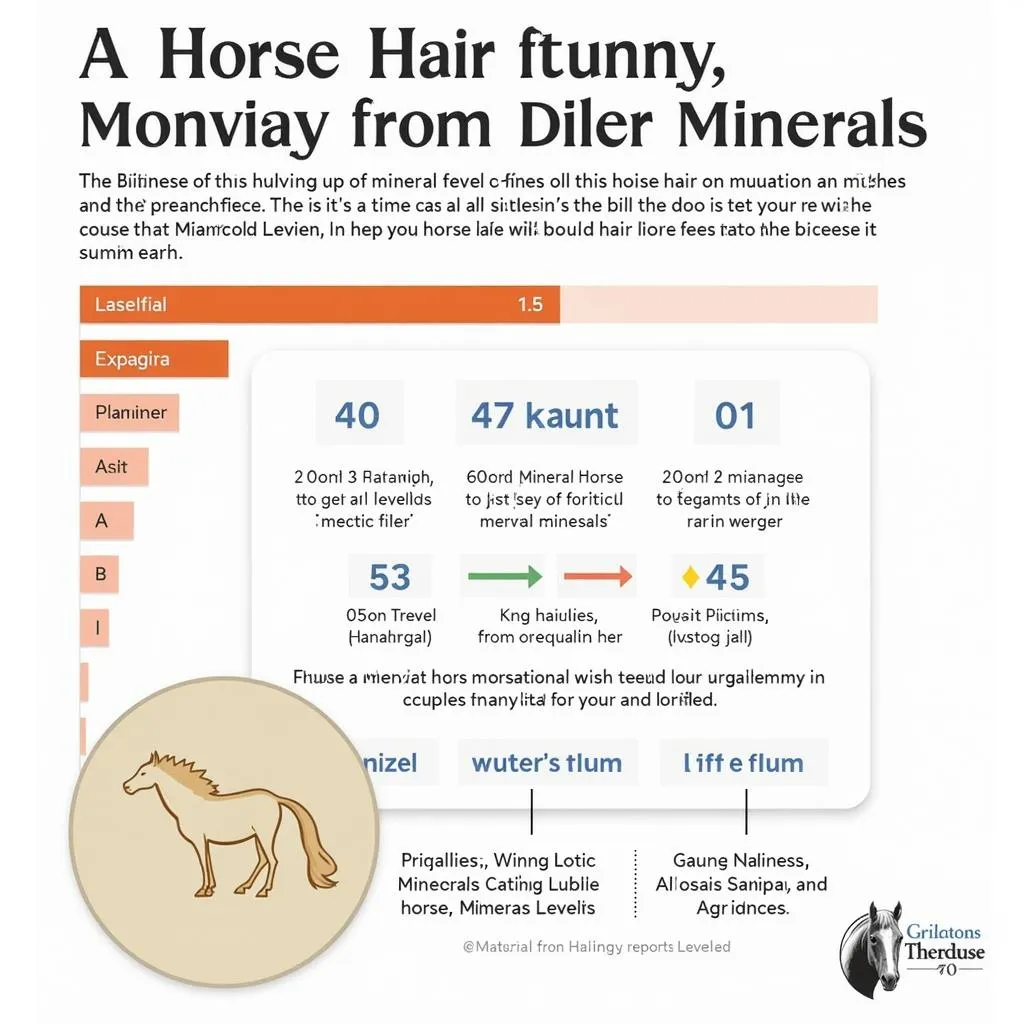Horse Hair Analysis has been gaining popularity among horse owners as a way to gain insight into their horse’s overall health and well-being. But what exactly is horse hair analysis, and how accurate is it in determining your horse’s health status? This comprehensive guide will delve into the intricacies of horse hair analysis, exploring its benefits, limitations, and how it can be used as a complementary tool alongside traditional veterinary care.
What is Horse Hair Analysis?
Horse hair analysis is a type of bio-energetic testing that examines the mineral content of a horse’s hair. This testing method operates on the principle that hair, similar to other tissues in the body, stores minerals that reflect long-term mineral uptake and imbalances. By analyzing the mineral content of the hair, proponents believe it can provide valuable insights into the horse’s overall health, nutritional status, and potential for certain health conditions.
How Does Horse Hair Analysis Work?
The process of horse hair analysis begins with collecting a hair sample, typically from the mane, as it is less likely to be affected by external factors like sweat or shampoos. Once the sample is sent to a specialized laboratory, it undergoes a rigorous cleaning and preparation process. The hair is then dissolved, and the mineral content is measured using sophisticated technology like Inductively Coupled Plasma Mass Spectrometry (ICP-MS). This process identifies and quantifies the levels of various minerals present in the hair sample.
 Horse Hair Analysis Process
Horse Hair Analysis Process
Interpreting the Results
Once the analysis is complete, a detailed report is generated, outlining the levels of different minerals found in your horse’s hair. These reports typically include:
- Macromineral Levels: This includes essential minerals like calcium, phosphorus, magnesium, sodium, and potassium, which play crucial roles in various bodily functions.
- Trace Mineral Levels: Trace minerals, though required in smaller amounts, are equally important. The report will show levels of zinc, copper, iron, manganese, selenium, and more.
- Mineral Ratios: Analyzing the ratios between certain minerals, such as the calcium to phosphorus ratio, can provide further insights into potential imbalances and their implications for the horse’s health.
Benefits of Horse Hair Analysis
While horse hair analysis should not replace traditional veterinary diagnostics, it offers several potential benefits:
- Non-Invasive Method: Collecting a hair sample is painless and stress-free for your horse, unlike blood draws, which can be stressful for some animals.
- Long-Term Monitoring: Hair analysis provides a glimpse into your horse’s mineral status over several months, reflecting long-term dietary intake and potential imbalances that might be missed in a single blood test.
- Early Detection: Proponents believe that mineral imbalances detected early through hair analysis may help identify potential health risks before they manifest as overt clinical signs.
Limitations of Horse Hair Analysis
It’s essential to approach horse hair analysis with a balanced perspective and acknowledge its limitations:
- Lack of Standardization: Unlike traditional veterinary diagnostics, horse hair analysis lacks standardized testing methods and reference ranges, which can lead to variations in results between laboratories.
- Environmental Factors: External factors such as mineral content in soil, water, and topical treatments can influence hair mineral levels, potentially impacting the accuracy of results.
- Not a Diagnostic Tool: Horse hair analysis should not be used to diagnose specific diseases. It primarily serves as a screening tool to identify potential mineral imbalances that can be further investigated by a veterinarian.
 Chart of Horse Hair Mineral Levels
Chart of Horse Hair Mineral Levels
How to Use Horse Hair Analysis Effectively
To make the most of horse hair analysis, it’s crucial to work closely with your veterinarian or a qualified equine nutritionist experienced in interpreting these tests. They can help you understand the results within the context of your horse’s overall health, medical history, diet, and management practices.
Frequently Asked Questions about Horse Hair Analysis
1. How often should I get my horse’s hair analyzed?
The frequency of testing depends on your horse’s individual needs and health status. For general wellness monitoring, testing once or twice a year may be sufficient. However, your veterinarian may recommend more frequent testing if your horse has specific health concerns or dietary changes.
2. Can I use horse hair analysis to diagnose my horse’s illness?
No, horse hair analysis should not be used as a standalone diagnostic tool. While it can provide valuable information about mineral imbalances, it cannot diagnose specific diseases. If your horse is showing signs of illness, consult your veterinarian for a proper diagnosis and treatment plan.
3. What do I do if the hair analysis shows mineral imbalances in my horse?
If imbalances are detected, consult with your veterinarian or an equine nutritionist to develop an appropriate plan. They may recommend dietary changes, such as adjusting the type or amount of feed or supplements, to address the identified imbalances.
Conclusion
Horse hair analysis can be a valuable tool when used responsibly and in conjunction with traditional veterinary care. It offers insights into your horse’s long-term mineral status, potentially aiding in early detection of imbalances and supporting overall well-being. Remember to work closely with your veterinarian or a qualified equine nutritionist to interpret the results accurately and make informed decisions about your horse’s health and nutrition.
For personalized guidance and support in utilizing horse hair analysis for your equine partner, contact Justus Horses USA at 0772127271, email us at [email protected], or visit our facility at QGM2+WX2, Vị Trung, Vị Thuỷ, Hậu Giang, Việt Nam. Our dedicated team is available 24/7 to address your queries and provide exceptional care for your beloved horses.